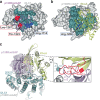SH3 domain regulation of RhoGAP activity: Crosstalk between p120RasGAP and DLC1 RhoGAP
- PMID: 35970859
- PMCID: PMC9378701
- DOI: 10.1038/s41467-022-32541-4
SH3 domain regulation of RhoGAP activity: Crosstalk between p120RasGAP and DLC1 RhoGAP
Abstract
RhoGAP proteins are key regulators of Rho family GTPases and influence a variety of cellular processes, including cell migration, adhesion, and cytokinesis. These GTPase activating proteins (GAPs) downregulate Rho signaling by binding and enhancing the intrinsic GTPase activity of Rho proteins. Deleted in liver cancer 1 (DLC1) is a tumor suppressor and ubiquitously expressed RhoGAP protein; its activity is regulated in part by binding p120RasGAP, a GAP protein for the Ras GTPases. In this study, we report the co-crystal structure of the p120RasGAP SH3 domain bound directly to DLC1 RhoGAP, at a site partially overlapping the RhoA binding site and impinging on the catalytic arginine finger. We demonstrate biochemically that mutation of this interface relieves inhibition of RhoGAP activity by the SH3 domain. These results reveal the mechanism for inhibition of DLC1 RhoGAP activity by p120RasGAP and demonstrate the molecular basis for direct SH3 domain modulation of GAP activity.
© 2022. The Author(s).
Conflict of interest statement
The authors declare no competing interests.
Figures







Similar articles
-
Functional cross-talk between ras and rho pathways: a Ras-specific GTPase-activating protein (p120RasGAP) competitively inhibits the RhoGAP activity of deleted in liver cancer (DLC) tumor suppressor by masking the catalytic arginine finger.J Biol Chem. 2014 Mar 7;289(10):6839-6849. doi: 10.1074/jbc.M113.527655. Epub 2014 Jan 17. J Biol Chem. 2014. PMID: 24443565 Free PMC article.
-
p120Ras-GAP binds the DLC1 Rho-GAP tumor suppressor protein and inhibits its RhoA GTPase and growth-suppressing activities.Oncogene. 2009 Mar 19;28(11):1401-9. doi: 10.1038/onc.2008.498. Epub 2009 Jan 19. Oncogene. 2009. PMID: 19151751 Free PMC article.
-
p200 RhoGAP promotes cell proliferation by mediating cross-talk between Ras and Rho signaling pathways.J Biol Chem. 2007 Mar 23;282(12):8801-11. doi: 10.1074/jbc.M609375200. Epub 2007 Feb 1. J Biol Chem. 2007. PMID: 17272280
-
p120-Ras GTPase activating protein (RasGAP): a multi-interacting protein in downstream signaling.Biochimie. 2009 Mar;91(3):320-8. doi: 10.1016/j.biochi.2008.10.010. Epub 2008 Oct 30. Biochimie. 2009. PMID: 19022332 Review.
-
Regulation of deleted in liver cancer 1 tumor suppressor by protein-protein interactions and phosphorylation.Int J Cancer. 2014 Jul 15;135(2):264-9. doi: 10.1002/ijc.28505. Epub 2013 Oct 17. Int J Cancer. 2014. PMID: 24114040 Review.
Cited by
-
Dynamic regulation of RAS and RAS signaling.Biochem J. 2023 Jan 13;480(1):1-23. doi: 10.1042/BCJ20220234. Biochem J. 2023. PMID: 36607281 Free PMC article.
-
The Anticancer Effects of Marine Carotenoid Fucoxanthin through Phosphatidylinositol 3-Kinase (PI3K)-AKT Signaling on Triple-Negative Breast Cancer Cells.Molecules. 2023 Dec 21;29(1):61. doi: 10.3390/molecules29010061. Molecules. 2023. PMID: 38202644 Free PMC article.
-
Nickel binding to c-Src SH3 domain facilitates crystallization.bioRxiv [Preprint]. 2025 May 28:2025.05.08.652639. doi: 10.1101/2025.05.08.652639. bioRxiv. 2025. PMID: 40463187 Free PMC article. Preprint.
-
Genomic and Reverse Translational Analysis Discloses a Role for Small GTPase RhoA Signaling in the Pathogenesis of Schizophrenia: Rho-Kinase as a Novel Drug Target.Int J Mol Sci. 2023 Oct 26;24(21):15623. doi: 10.3390/ijms242115623. Int J Mol Sci. 2023. PMID: 37958606 Free PMC article. Review.
-
Functional Classification and Interaction Selectivity Landscape of the Human SH3 Domain Superfamily.Cells. 2024 Jan 20;13(2):195. doi: 10.3390/cells13020195. Cells. 2024. PMID: 38275820 Free PMC article.
References
Publication types
MeSH terms
Substances
Grants and funding
LinkOut - more resources
Full Text Sources
Research Materials
Miscellaneous

